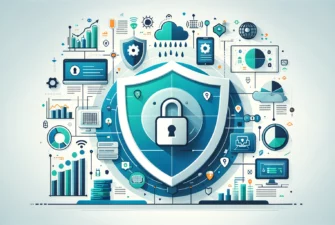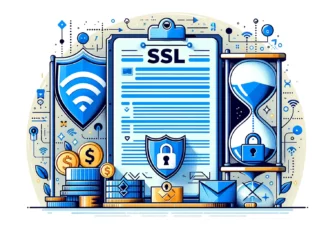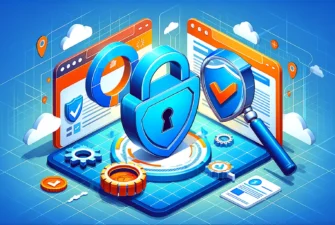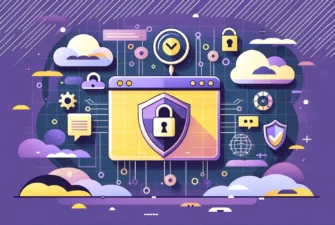
When you consider the security of your online transactions, you will stumble across digital signatures and certificates. These elements are the backbone of sensitive data protection.
You may wonder how they operate together to improve safety or what sets them apart. Stick around as we explore the digital signature vs digital certificate differences, from how they work to their usage, benefits, and limitations. Let’s start with the very basics.
Table of Contents
- What Is a Digital Signature?
- How Does a Digital Signature Work?
- Where Are Digital Signatures Used and Who Uses Them?
- How to Get a Digital Signature?
- What Is a Digital Certificate?
- Where Are Digital Certificates Used and Who Uses Them?
- How to Get a Digital Certificate?
- Digital Certificate Advantages
- Digital Certificate Disadvantages
- What Is the Difference between Digital Signatures and Digital Certificates?
What Is a Digital Signature?
A digital signature is a type of electronic signature that uses a cryptographic technique to authenticate the origin and integrity of digital documents, messages, or software. It employs a mathematical algorithm to generate a unique digital fingerprint, or “signature,” for a specific piece of data. This signature is individual to the sender and the content signed, providing assurance of the sender’s identity and ensuring that the data remains intact during transmission.
Digital signatures are classified as follows:
- Class 1 Signatures (Email Signatures): These signatures verify the connection between an email address and its rightful owner, providing email authenticity.
- Class 2 Signatures (Identity-Based Signatures): This type of signature validates a person’s identification by comparing it to a pre-verified database.
- Class 3 Signatures (In-Person Validated Signatures): These signatures are granted after validating the individual applying in person, ensuring higher trust and validation for critical financial transactions, such as online shopping platforms and electronic tendering.
Now, let’s see how they work step by step.
How Does a Digital Signature Work?
- Creation: To sign a digital document, the signer first creates a unique digital signature using a cryptographic algorithm, as specified by the digital signature standard. This algorithm ensures the security and uniqueness of the signature.
- Encryption: The digital signature is then encrypted using the signer’s private key, which is part of a key pair associated with a digital signature certificate. This certificate, issued by a trusted Certificate Authority, contains information about the signer’s identity and public key.
- Attachment: The encrypted digital signature is attached to the digital document, either as a separate file or integrated within the document itself. This process ensures that the signature is inseparable from the document it authenticates.
- Verification: Upon receiving the digitally signed document, the recipient uses the signer’s public key, obtained from the digital signature certificate, to decrypt the signature. This step verifies the authenticity of the signature and its association with the document.
- Integrity Check: The recipient performs an integrity check on the document using a hash function. It confirms that the document has not been altered since it was signed, thus maintaining its integrity.
- Authentication: If the decrypted signature matches the document and the integrity check passes, the recipient can trust that the document is authentic and has not been tampered with.
Where Are Digital Signatures Used and Who Uses Them?
Digital signatures are widely adopted across various industries, from government agencies to private corporations. They serve as a more secure alternative to traditional electronic signatures by employing complex algorithms.
This technology is critical in sectors where data security and proof of digital identity are essential. In the banking and finance industry, digital signatures secure transactions and agreements, while in legal settings, they confirm the authenticity of legal documents.
Healthcare providers utilize digital signatures to protect patient records, and government entities employ them to secure official paperwork and streamline administrative processes. Additionally, a digital signature safeguards the digital assets of all kinds of businesses. Their adoption highlights the emphasis on data integrity, efficiency, and compliance in electronic transactions.
Digital Signatures Advantages
By leveraging cryptography, digital signatures secure your data, making it virtually impossible for unauthorized parties to alter the contents of a document without detection. This fundamental feature of data integrity means that you can trust the information presented in a digitally signed document is exactly as the signer intended.
When you utilize digital signatures, you’re not just protecting the documents. You’re also simplifying procedures and enhancing overall security. Here are some key benefits:
- Efficiency: Transactions are faster since documents can be signed and sent digitally, eliminating the need for physical presence or mailing.
- Cost Reduction: Reduces the need for paper, printing, and postage, translating into significant savings over time.
- Legally Binding: In many jurisdictions, digital signatures have the same legal standing as traditional handwritten signatures.
- Enhanced Security: Features such as timestamping and unique signer identification add layers of security beyond what’s possible with physical documents.
- Global Acceptance: Digital signatures are widely recognized and accepted across borders, facilitating international business transactions.
- Regulatory Compliance: Digital signatures help organizations comply with various regulatory requirements related to document authentication and integrity, such as GDPR in the European Union or HIPAA in the healthcare industry.
Digital Signatures Disadvantages
- Complexity in Key Management: Cryptographic keys and certificate management are challenging, demanding additional resources and expertise to ensure proper implementation.
- Reliance on Technological Infrastructure: Digital signatures depend on Public Key Infrastructure (PKI), including secure platforms and trustworthy certificate authorities, which can be challenging to establish and maintain in distinct environments.
- Compatibility Issues: Software compatibility is crucial, as it must support the specific digital signature technology, adding another layer of complexity to the process.
- Standardization Challenges: Establishing smooth interaction across diverse systems demands standardization, given the varied methods and technologies involved in digital signature implementation.
- Financial Considerations: Effectively utilizing digital signatures frequently involves the acquisition of digital certificates and verification software, which can result in substantial costs for both senders and recipients.
How to Get a Digital Signature?
Obtaining a digital signature requires a series of technical steps. It all starts with the choice of a third-party certificate authority. This initial selection is very important because the reliability and security of your digital signature hinge on the integrity of the CA.
- Select a Trusted CA: Begin by choosing a reputable Certificate Authority known for its strong security measures.
- Verify Your Identity: Submit the necessary documentation to confirm your or your organization’s identity for validation.
- Generate Key Pair: Use cryptographic software such as OpenSSL to generate a private and public key – essential for digital signature creation and verification.
- Obtain Your Digital Signature: The CA issues a digital signature certificate, linking your identity to your public key. It assures the authenticity of your digital signatures.
- Installation and Usage: Install the digital signature certificate on your server or application to digitally sign documents securely.
As you can see, we have already mentioned the digital certificate in the context of digital signatures, that’s because they are part of a greater system that protects digital data. In the next sections, we’ll discuss digital certificates.
What Is a Digital Certificate?
A digital certificate is an electronic document used to verify the identity of an entity, such as a person, a computer, a website, or an organization, over digital networks like the Internet. It contains information about the entity’s identity, public key, and the digital signature of a trusted third party, known as a Certificate Authority, which confirms the authenticity of the information.
How Does a Digital Certificate Work?
Here’s a step-by-step explanation of how digital certs function:
- Public Key Cryptography: Digital certificates rely on public key cryptography. This system uses pairs of keys: a public key and a private key.
- Sender’s Private Key: When a sender wants to transmit information securely, they use their private key to create a digital signature for the data. This signature is unique to the sender and the data transmitted.
- Sender’s Public Key: The sender’s public key is widely available to anyone who needs to verify the sender’s identity or decrypt data encrypted with the sender’s private key.
- Public and Private Keys: The sender keeps their private key secret and never shares it with anyone. However, they freely distribute their public key to others.
- The CA Issues Digital Certificates: These certificates contain the sender’s public key and other identifying information, such as their name and organization.
- Digital Signature: The CA digitally signs the certificates using its private key, ensuring the authenticity of the information.
- Verification: When a recipient receives data from the sender, they use the sender’s public key (obtained from the digital certificate) to verify the digital signature on the data. If the signature matches the sender’s public key, the recipient can be confident that the data has not been tampered with and that it indeed came from the claimed sender.
Where Are Digital Certificates Used and Who Uses Them?
The examples below illustrate the diverse industries and entities that rely on digital certificates to establish secure online transactions and communications.
- Website Browsers: Browsers such as Google Chrome, Mozilla Firefox, Microsoft Edge, and Apple Safari use digital certificates, also known as SSL certificates, to verify website identities, establish secure connections, display security indicators to users, and warn them of potential risks.
- Email Security: Digital certificates, specifically S/MIME certificates, are used to encrypt emails sent between users, ensuring that only the intended recipients can access the content of the messages.
- E-commerce Websites: Websites like Amazon, eBay, and Shopify use digital certificates to secure online transactions, ensuring that your personal and financial information remains confidential during purchases.
- IoT Devices: Internet of Things (IoT) devices such as smart thermostats, security cameras, and wearable devices use digital certificates to establish secure connections with other devices or servers, safeguarding data transmitted over the network.
- VPN Providers: Virtual Private Network (VPN) uses digital certificates to authenticate and encrypt connections between users’ devices and their VPN servers, ensuring privacy and security while browsing the internet.
- Software Companies: Developers use code signing certificates to sign their software applications, assuring users that their downloadable goods are genuine.
Digital Certificates Features
Here’s a list of the most important features of a digital certificate:
- Authentication: Verifies the identity of individuals, devices, or entities in online transactions.
- Data Integrity: Ensures that data remains unchanged and unaltered during transmission.
- Encryption: Secures data by converting it into an unreadable format that can only be decrypted with the corresponding private key.
- Key Management: Facilitates the secure generation, storage, and distribution of cryptographic keys.
- Revocation: Allows for the invalidation of certificates if they are compromised or no longer trustworthy.
- Compliance: Adheres to industry standards and regulations such as X.509, PKCS, and GDPR.
- Validity Period: Specifies the duration for which the certificate is considered valid before it needs to be renewed or reissued.
How to Get a Digital Certificate?
SSL Dragon offers affordable certificates for every need, from website authentication to email security and software protection. You can use our SSL Wizard to find the best digital certificate for your project. Here’s a quick walkthrough:
- Choose a certificate authority based on security needs and budget.
- Generate a Certificate Signing Request (CSR) with server keys and organization info.
- Submit CSR to CA to start the application process.
- Wait till CA validates details, including organization and domain ownership.
- Download and install the issued certificate on the server.
Digital Certificate Advantages
Without digital certs, sending data securely over the web wouldn’t be possible. Here are their primary benefits:
- Strong Encryption: Digital certificates employ AES encryption, a widely accepted and highly secure encryption standard that protects shared data.
- Authentication: They provide a reliable means of verifying the identity of users, devices, or entities involved in online transactions, reducing the risk of impersonation or fraud.
- Scalability: Digital certs offer scalability, enabling efficient management and deployment across large-scale networks and diverse applications without compromising security or performance.
- Trustworthiness: Digital certificates establish trust in online interactions by validating the authenticity of the parties involved, enabling a secure environment for e-commerce, communication, and other digital transactions.
Digital Certificate Disadvantages
- Cost: Most digital certificates cost around $100 or less, but some types are more expensive. Implementing and maintaining them can take a toll on your budget, including certificate issuance fees, infrastructure setup, and ongoing management expenses, particularly for large-scale deployments.
- Sophistication: Managing digital certificates involves complexities such as key generation, certificate renewal, and revocation management, requiring specialized expertise.
- Single Point of Failure: Reliance on a centralized Certificate Authority for issuing and validating certificates can create a single point of failure, potentially disrupting entire systems if the CA is compromised.
- Certificate Lifecycle Management: Digital certificates have finite lifetimes and require timely renewal or replacement to maintain operational continuity. Failure to manage certificate lifecycles effectively can lead to service interruptions or security vulnerabilities.
What Is the Difference between Digital Signatures and Digital Certificates?
Digital signatures and certificates work in tandem to ensure the authenticity and integrity of electronic documents or communications, but they serve different purposes.
A digital signature is like a virtual fingerprint that uniquely identifies the message sender or document author. It’s created using a cryptographic algorithm attached to the document or message. When someone signs a document digitally, they form a mathematical representation of the document that is unique to them.
This signature can be verified by anyone using the signer’s public key, ensuring that the document hasn’t been tampered with and that it came from the asserted sender.
On the other hand, a digital certificate is like a digital ID card issued by a CA. It contains information about the certificate holder, such as their business name and public key, and is used to verify ownership and identity.
When someone receives a digitally signed document, they can use the signer’s digital certificate to verify the signature’s authenticity. This is possible because the digital certificate is issued by a trusted CA, which means that the information it contains has been verified and can be relied upon.
Bottom Line
Now that you understand the digital signature vs digital certificate difference, you’re equipped to distinguish their specific roles in cybersecurity. Digital signatures verify the origin and integrity of data, while digital certificates validate the identities of parties in online communications. This knowledge empowers you to implement effective security measures and mitigate cyber risks confidently.
Save 10% on SSL Certificates when ordering today!
Fast issuance, strong encryption, 99.99% browser trust, dedicated support, and 25-day money-back guarantee. Coupon code: SAVE10



























